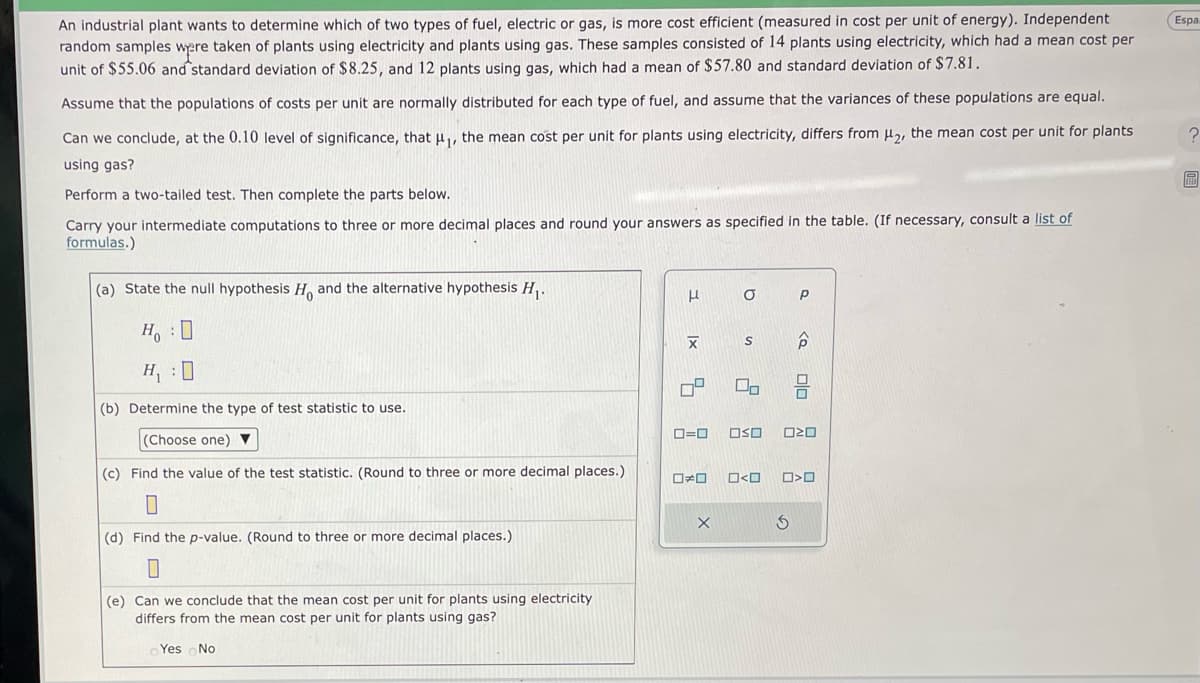An industrial plant wants to determine which of two types of fuel, electric or gas, is more cost efficient (measured in cost per unit of energy). Independent random samples were taken of plants using electricity and plants using gas. These samples consisted of 14 plants using electricity, which had a mean cost per unit of $55.06 and standard deviation of $8.25, and 12 plants using gas, which had a mean of $57.80 and standard deviation of $7.81. Assume that the populations of costs per unit are normally distributed for each type of fuel, and assume that the variances of these populations are equal. Can we conclude, at the 0.10 level of significance, that μ₁, the mean cost per unit for plants using electricity, differs from μ₂, the mean cost per unit for plants using gas? Perform a two-tailed test. Then complete the parts below. Carry your intermediate computations to three or more decimal places and round your answers as specified in the table. (If necessary, consult a list of formulas.) (a) State the null hypothesis H and the alternative hypothesis H₁. HO H₁:0 (b) Determine the type of test statistic to use. (Choose one) (c) Find the value of the test statistic. (Round to three or more decimal places.) 0 (d) Find the p-value. (Round to three or more decimal places.) 0 (e) Can we conclude that the mean cost per unit for plants using electricity differs from the mean cost per unit for plants using gas? Yes No I X 4 00 O X S 0=0 OSO 00 O>O G Р O
An industrial plant wants to determine which of two types of fuel, electric or gas, is more cost efficient (measured in cost per unit of energy). Independent random samples were taken of plants using electricity and plants using gas. These samples consisted of 14 plants using electricity, which had a mean cost per unit of $55.06 and standard deviation of $8.25, and 12 plants using gas, which had a mean of $57.80 and standard deviation of $7.81. Assume that the populations of costs per unit are normally distributed for each type of fuel, and assume that the variances of these populations are equal. Can we conclude, at the 0.10 level of significance, that μ₁, the mean cost per unit for plants using electricity, differs from μ₂, the mean cost per unit for plants using gas? Perform a two-tailed test. Then complete the parts below. Carry your intermediate computations to three or more decimal places and round your answers as specified in the table. (If necessary, consult a list of formulas.) (a) State the null hypothesis H and the alternative hypothesis H₁. HO H₁:0 (b) Determine the type of test statistic to use. (Choose one) (c) Find the value of the test statistic. (Round to three or more decimal places.) 0 (d) Find the p-value. (Round to three or more decimal places.) 0 (e) Can we conclude that the mean cost per unit for plants using electricity differs from the mean cost per unit for plants using gas? Yes No I X 4 00 O X S 0=0 OSO 00 O>O G Р O
Glencoe Algebra 1, Student Edition, 9780079039897, 0079039898, 2018
18th Edition
ISBN:9780079039897
Author:Carter
Publisher:Carter
Chapter10: Statistics
Section10.4: Distributions Of Data
Problem 19PFA
Related questions
Question

Transcribed Image Text:An industrial plant wants to determine which of two types of fuel, electric or gas, is more cost efficient (measured in cost per unit of energy). Independent
random samples were taken of plants using electricity and plants using gas. These samples consisted of 14 plants using electricity, which had a mean cost per
unit of $55.06 and standard deviation of $8.25, and 12 plants using gas, which had a mean of $57.80 and standard deviation of $7.81.
Assume that the populations of costs per unit are normally distributed for each type of fuel, and assume that the variances of these populations are equal.
Can we conclude, at the 0.10 level of significance, that μ₁, the mean cost per unit for plants using electricity, differs from μ₂, the mean cost per unit for plants
using gas?
Perform a two-tailed test. Then complete the parts below.
Carry your intermediate computations to three or more decimal places and round your answers as specified in the table. (If necessary, consult a list of
formulas.)
(a) State the null hypothesis H and the alternative hypothesis H₁.
H: D
H₁ : 0
(b) Determine the type of test statistic to use.
(Choose one) ▼
(c) Find the value of the test statistic. (Round to three or more decimal places.)
(d) Find the p-value. (Round to three or more decimal places.)
(e) Can we conclude that the mean cost per unit for plants using electricity
differs from the mean cost per unit for plants using gas?
Yes No
3
Ix
X
4
O
S
X
2
0=0 OSO
☐#0 0<0
Р
S
<Q
00
020
>O
Espa.
?
A
Expert Solution
This question has been solved!
Explore an expertly crafted, step-by-step solution for a thorough understanding of key concepts.
This is a popular solution!
Trending now
This is a popular solution!
Step by step
Solved in 2 steps

Follow-up Questions
Read through expert solutions to related follow-up questions below.
Follow-up Question
what is the degree of freedom? is it 14 ? or 13?
and is a not numbers
Solution
Recommended textbooks for you

Glencoe Algebra 1, Student Edition, 9780079039897…
Algebra
ISBN:
9780079039897
Author:
Carter
Publisher:
McGraw Hill

Glencoe Algebra 1, Student Edition, 9780079039897…
Algebra
ISBN:
9780079039897
Author:
Carter
Publisher:
McGraw Hill